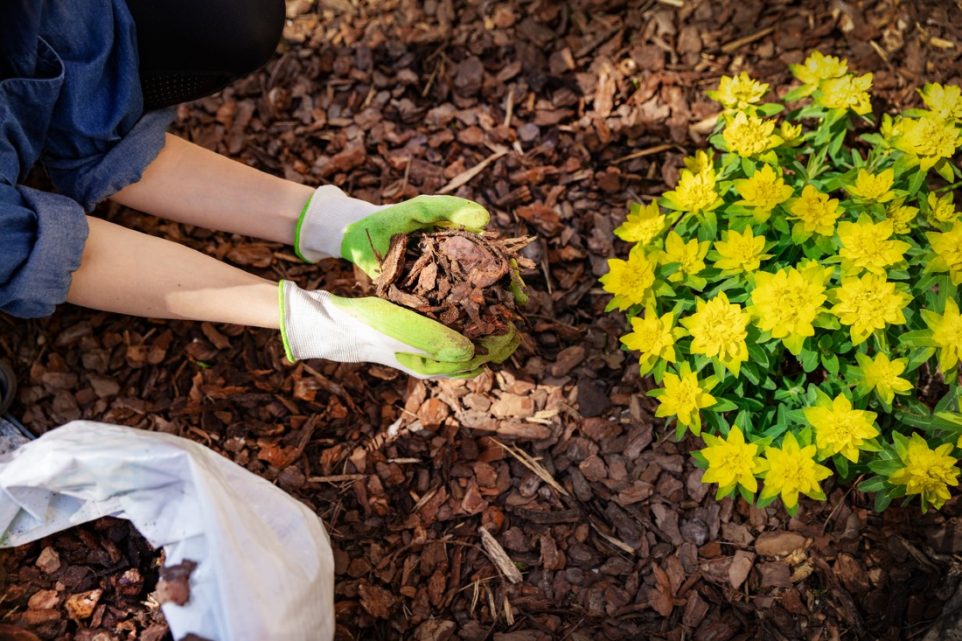Mulch vs. Wood Chips: Which Is Better for Your Yard?

Comparing the basic functions and benefits of mulch and wood chips is essential in determining the best option for your yard. The choice between the two may not be straightforward, as it depends on various factors, such as the specific needs of your plants, local climate, and desired maintenance level.
Both mulch and wood chips have their unique sets of advantages as well as potential drawbacks to consider. In this post, we will compare these two options to help you make an informed decision for your yard.
What is Mulch?
Mulch is a broad term that refers to any material spread over the soil’s surface as a covering. It helps to retain soil moisture, reduce weed growth, regulate soil temperature, and improve garden bed aesthetics. Mulch can be organic, such as shredded bark, straw, or compost, or inorganic, like rubber or gravel.
Benefits of Mulch for Your Yard
One of the primary benefits of mulch is its ability to retain soil moisture. By covering the soil, mulch reduces the rate of evaporation, thereby decreasing the need for watering and helping plants withstand periods of low rainfall.
Additionally, mulch acts as an effective weed barrier. It suppresses weed germination and growth by blocking sunlight from reaching the soil surface, significantly reducing the time and effort required for weed management.
Temperature regulation is another key benefit provided by mulch. It’s an insulating layer for soil, keeping it cooler during the hot summer months and preventing frost heaving in colder climates.
Organic mulch, which includes materials like shredded leaves, straw, and wood chips, offers the added benefit of enriching the soil as it breaks down. This adds valuable organic matter to the soil, improving its structure and fertility and encouraging beneficial microbial activity.
In terms of visual appeal, mulch can enhance the look of a garden by providing a clean, unified ground cover that highlights plants and features. You can give it an even more appealing, custom look by applying a rock or mulch glue. Mulch can also help to prevent soil erosion on slopes by absorbing water and reducing runoff.
Potential Drawbacks of Mulch
Over-mulching can lead to excess moisture retention, which may cause root rot or fungal growth detrimental to plant health. It’s crucial to apply the appropriate amount and avoid piling mulch against the stems or trunks of plants, as this can invite pests and diseases.
Organic mulch, although beneficial for soil enrichment, can deplete nitrogen levels during the decomposition process. Plants may experience a temporary deficiency, requiring additional fertilization to offset the nitrogen consumed by decomposing organisms.
While a good mulch glue can promote longevity, maintenance is another consideration, as you’ll need to replace or replenish organic mulch as it breaks down. This can contribute to ongoing garden work and expenses.
In some instances, mulch can also attract unwanted pests like termites, carpenter ants, and rodents, depending on the material used and the local environment. It’s imperative to select mulch that is less likely to harbor these pests or take preventative measures to mitigate the risk.
What are Wood Chips?
Wood chips are a specific type of organic mulch that is typically produced from chipped branches, limbs, and stumps. They are an excellent choice for creating a natural-looking landscape and are often favored for their ability to decompose and enrich the soil over time. Many homeowners even generate their own wood chips using a wood chipper, allowing for the recycling of tree trimmings and other yard waste.
Benefits of Wood Chips for Your Yard
Wood chips excel at retaining soil moisture, as they create a protective barrier that slows down evaporation. This is especially useful during hot, dry periods, helping to conserve water and reduce the frequency of irrigation.
Additionally, wood chips are effective at suppressing weed growth. Their coverage blocks light from reaching the soil surface, which inhibits the germination of weed seeds and minimizes the need for manual weed control.
Temperature regulation is another key advantage of using wood chips. They provide an insulating layer that can help moderate soil temperature fluctuations, keeping plant roots cooler in summer and protected from cold in winter.
As wood chips are organic, they gradually decompose, releasing nutrients into the soil and improving its fertility and structure. This process fosters a healthy soil ecosystem that can support robust plant growth.
From an aesthetic standpoint, wood chips can enhance the natural beauty of a yard. They offer a rustic charm and can create defined pathways, accentuate garden borders, or provide a uniform ground cover that ties together various elements of a landscape design.
Potential Drawbacks of Wood Chips
If wood chips are not properly applied, they can form a dense mat that prevents water and air from reaching the soil, potentially harming plant roots. You should take care to spread wood chips evenly and not pile them too thickly around plants.
Another concern is that, as wood chips decompose, they can temporarily tie up nitrogen in the soil, making it less available to plants. You can avoid this by supplementing with a nitrogen-rich fertilizer, which requires additional attention and maintenance.
While wood chips naturally break down and enrich the soil, this process can also attract certain insects and fungi. For instance, wood chips might provide a habitat for termites or carpenter ants, posing a risk to wooden structures nearby.
Furthermore, the initial cost and effort to obtain and spread wood chips can be a consideration, especially for those who don’t have a wood chipper or access to free wood chips. Purchasing pre-chipped wood can be an expense, and spreading them across large areas can be labor-intensive.